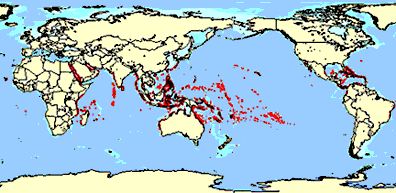Coral
Reefs Scenario
Below is the article "Reef Disease: Alarming Increase"
that appeared in the Apr/May 1998 issue of National Wildlife
(Vol. 36, Num. 3).
 ou
don't need to be a scientist to have a fairly good idea
of what these diseases do to coral reefs: white pox, rapid
wasting disease, patchy necrosis, white plague or black-band
disease. Those are among more than a dozen known infections
that attack coral tissue or skeletonķand that are increasing
at an alarming rate in some areas. ou
don't need to be a scientist to have a fairly good idea
of what these diseases do to coral reefs: white pox, rapid
wasting disease, patchy necrosis, white plague or black-band
disease. Those are among more than a dozen known infections
that attack coral tissue or skeletonķand that are increasing
at an alarming rate in some areas.
Last fall,
researchers from an Environmental Protection Agency
monitoring program announced that disease on Florida's
coral reefs increased by a whopping 292 percent from
1996 to 1997. Not only has the number of coral species
with ailments grown, so has the number of diseases,
including some that are new to science. "We are
really stunned at what we found," says ecologist
James W. Porter of the University of Georgia. "There
is no precedent for what has happened in the past year."
Corals, which
are animals, carry in their tissues symbiotic algae
that allow the hosts to produce more oxygen than they
consume.
|
That
productivity is crucial to the overall health of coral
reefs, which support a wealth of fishes and other sea
life.
Scientists
think that changes in the ecosystem have made corals
increasingly susceptible to scourges that have long
existed in ocean waters. Also discovered last year were
sick fishes swimming on the reefs, including some with
red spots similar to the lesions caused by recent outbreaks
of the microbe Pfiesteria along the mid-Atlantic
seaboard. Among the causes theorized for the reefs'
ailing health are poor water quality and polluted or
disease-bearing runoff from land into Florida Bay.
Florida is
not alone. The first global survey of coral-reef health,
called Reef Check, recently found that about 95 percent
of the world's coral reefs have been damaged by over-fishing,
dynamiting, poisoning, pollution or ships' anchors.
"The results are very shocking," says study
coordinator and marine biologist Gregor Hodgson of Hong
Kong University of Science and Technology.
|
Below
is a map produced by digitizing maps and presenting them in
uniform formats. The coral reefs are represented in red. (Source
- ReefBase
by the World Conservation Monitoring Centre in Cambridge,
UK)

Coral
reefs comprise some of the greatest areas of biodiversity
on Earth, rivaling the biodiversity of the rain forests. Like
the tropical rain forests, coral reefs are found only in the
tropical and semi-tropical areas of the world where water
temperatures range from 16ēC to 30ēC. Generally coral reefs
are found within 30° latitude of the equator.
The current coral
reefs resulted from production that occurred over the
past five to ten thousand years. The actual coral makes
up only a small part of the life found on the reefs but
provides habitat for numerous other species. Coral reefs play
an important role in providing a food source and a living
for many people, especially in developing nations such as
the Philippines and the Dominican Republic. Anticancer drugs
and painkillers have been developed from coral reef products.
Research is now being done on a method to encourage bone growth
in humans by mimicing the coral secretions. Additionally,
coral reefs play an important role in biogeochemical cycles,
especially the carbon cycle.
In recent
years, some deterioration of known coral reefs has been noted.
Some experts suggest that ten percent of Earth's coral reefs
have already been destroyed and that another sixty percent
is in danger. There are dissenting opinions because of the
narrow surveying of reefs. Uncertainty exists since only
reefs close to population centers have been thoroughly surveyed.
Some causes of the destruction are obvious, like when Philippine
fishermen dynamite and inject cyanide into reefs, for example.
Other causes are more difficult to pinpoint. In addition
to the human influences of destruction, there are also natural
influences to be considered.
The National
Oceanic and Atmospheric Administration (NOAA) is concerned
that injured or destroyed marine habitats may indirectly upset
the ecological balance and the world's food chain. The
question then arises: even if coral reefs are being destroyed
at an alarming rate, why should we be concerned?
After all, the current coral reefs are only 5,000 to
10,000 years old.
Situation
An international team of coral reef scientists speaking at
the International Tropical Marine Ecosystems Management Symposium
conference at Australia's Great Barrier Reef reported that
ocean conditions in 1998 have affected almost all species
of corals, leading to unprecedented global coral bleaching
and mortality. A major outcome of the symposium was the
establishment of the International Coral Reef Initiative (ICRI)
to stop and reverse the global degradation of coral reefs
and associated ecosystems.
ICRI and
NASA's Earth Science Enterprise (ESE) have approached your
team of Earth Systems scientists for a thorough evaluation
of all the factors affecting coral reef survival. ESE
and ICRI are particularly interested in your team's recommendations
regarding how to deal with the situation.
Assignments
Over the next two weeks (Week A and Week B) you will work
individually and in teams to address the coral reef situation.
Use the links below to access your assignments.
Week A: Teacher
as Problem Solver
Private
Theory Activity and Rubric
Individually,
identify what you believe to be true and the reasons for why
you have those beliefs regarding coral reefs.
Week A: Teacher
as Problem Solver
Knowledge-Building
Activity and Rubric
As
a team, build ESS knowledge about the coral reefs event
described in the scenario, and develop a problem statement.
Week B: Teacher
as Model Builder
Model-Building
Activity and Rubric
Using
your team's original or revised problem statement, build an
ESS model that includes the ESS relationship statements and
evidence that support your conclusions (recommendations or solutions).
[
Back
to Outline ]
[
Home ] [ Intro
] [ Guide ] Outline [ Classroom
]
HTML code
by Chris Kreger
Maintained by ESSC Team
Last updated July 25, 2000
Privacy
Statement and CopyrightŠ
1997-2000 by Wheeling Jesuit University/NASA Classroom of the Future™. All
rights reserved.
|



